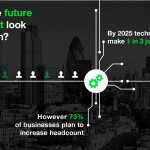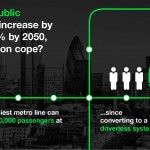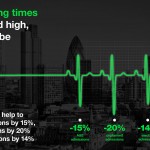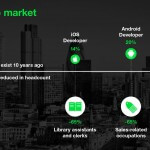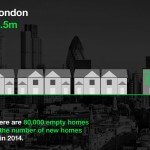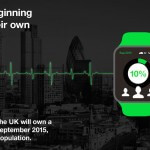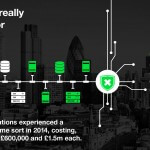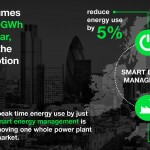Firstly I’d like to commend Bloomberg on their first BloombergLIVE event. The Bloomberg Technology Conference: Smarter Cities.
I attend a lot of these conferences and often I hear the same thing, in the same format, over and over again. The medium Bloomberg chose was, for me, exceptional. Instead of having mere figurehead chairpeople, they chose to use their resource of highly qualified TV journalists. Short presentations by speakers were followed by insightful interviews led by the journalists, with encouragement for audience participation. This change of format meant that instead of just being able to say what they liked in their presentation, the speakers had to follow up their statements by responding to questions and queries from the chairs who took notes throughout. This makes a big difference to the normally mumbled questions that come from ‘unsure if I should be asking this’ audience members.
Moving on from this point let’s recognise that London is well on its way to becoming a mega-city – that is, a city with more than 10 million occupants. As this rapid expansion continues, the tech city within the hub is working to make London more resilient and functional for the future.
Smart Cities are not just about IoT street lamps and noise pollution monitors. Looking towards the future, smarter cities will be integrated social experiences, allowing for transparency of government and engagement of city constituents.
Andrew Collinge, Assistant Director of Intelligence and Analytics for the Greater London Authority said “It’s up to city hall to be more deterministic when looking at smart cities.”
I think this is right, and the sentiment was echoed by many throughout the day, cities need to work together at a greater scale to become ‘smart’. London is unlucky in some ways, we are trying to retro-fit a centuries old infrastructure with modern technological solutions.
London is well on its way to becoming a mega-city – that is, a city with more than 10 million occupants
One of my favourite comments of the day was that technology companies often only see a problem that needs to be solved, and they design to fix a problem. You can’t approach a city as a problem, it is too big for that. The companies making tech that is really making a difference now aren’t trying to solve problems, they’re being much more innovative than that.
Smarter Cities and Power
Take PaveGen for example, their idea is incredible. Take something everyone does, every day, and innovate it to make a resource we all need. One step for power. Paving tiles, priced at the same point as flagged paving that in high traffic areas, will generate enough power to justify their existence. An installation of 200 tiles into a football pitch allows the energy generated by players to be stored and used to power floodlights to light the pitch.
Additionally, the data that can be collected from these tiles if they were located in shopping malls or within stores is invaluable. Being able to track footfall within a retail environment can show the retailer if its customers are lingering in certain areas, or if particular displays aren’t getting the footfall that they were expected.
Lawrence Kemball-Cook, CEO and Founder of PaveGen said originally they wanted to know if they could design a floor that would tweet every time it was stepped on, but they decided on the more practical end function of power generation.
Power supply and demand is now being looked at more intuitively also, when all of Britain decides to make a cup of tea after X-factor, the demand on the power grid is overwhelming. Power management companies are now looking at solutions that shut off non-crucial power supplies for short periods of time. For example, turning of the power to your fridge for 10 minutes does not have any negative ramifications, the fridge will maintain its temperature for short periods of time due to stored power. So when companies require energy for a huge task once a day, but it does not matter when this task happens, energy management means that this task can be relegated to a time where the demand on the grid is best able to handle it.
Smarter Cities and Health
Smart cities should be working to make people healthier, happier and more engaged with their environments. Health tech is progressing to become proactive in this regard. Looking to be preventative rather than solvent. Through improving mental health services through apps and online, more support is offered to people who otherwise would not access the services. It is proven that social connection forestalls mental illness, smart cities projects are not just about tech. As Katherine Oliver, Principle of Media and Technology at Bloomberg Associates put it; it’s about the three P’s. Parks, playgrounds and paths are key points for smart city development.
Smart cities and health go hand in hand. Tracking health outbreaks through wearables, twitter, and geotagged google searches allows for pharmaceutical companies to distribute drugs to the areas which need it most, and to predict and back track patterns of infection.
Technology innovation in cities to promote better health is not limited to the realm of healthcare itself. Traffic improvements, and smarter parking solutions reduce emissions by reducing the number of cars driving around looking for parking spaces. Emission management is a big part of success for cities in the future, improving air quality and reducing environmental impacts will be big focusses in the near future.
Smarter Cities and Transport
I have useless navigation skills – the perils of being in the GPS generation
We all use transport apps. Frankly, I wouldn’t be able to get around London without them, I have useless navigation skills – the perils of being in the GPS generation.
Travel data is vastly improving our quality of life. People are able to choose their mode of travel through many means, whether price is a priority, or if they just want the fastest route.
Giving people visibility to their transport infrastructures is changing the way they interact with their cities. Omid Ashtari, GM of City Mapper has received reviews along the lines of ‘I’m sitting on a bus that was two streets away from my house, getting to my destination faster than ever before, and before City Mapper I never even knew this bus stop existed.’
This is true. Apps are giving us travel options that we would not have considered previously. It might be faster to walk one station further away and get on a different line, rather than catching 3 trains to your destination. In Singapore they have gone one step further to make travel more hassle-free, they are supplying travellers with information on how crowded the busses are. Giving commuters the option to know a less-full bus is only 5 minutes away.
The Bigger Picture
“Amsterdam is NOT tracking old people.” My favourite inflammatory statement of the day from Ger Baron, the CTO of the City of Amsterdam.
There is so much potential for smart cities to improve quality of life. Partnerships between the public and private sectors can have real effect. Amsterdam has been working with supermarkets to see if anti-obesity advertising is changing the ways people shop. Collecting data on people’s shopping habits is allowing them to target their advertising more accordingly, in the hope of reducing health problems long term.
Following the Boston marathon bombings, outdoor advertising firm Clear Channel International used its smart connected to convey information to citizens in real time. Bus shelters and billboards are now able to have direct contact with citizens to improve their quality of life. Simple things like weather forecasts and bus times are conveyed daily – but in the event of a disaster smart cities really can make the lives of their occupants a little easier.
As I have said before, Smart cities are the future. The way we choose to live in them is up to us now. Personally I hope that we choose a socially conscious, environmentally sustainable future, but the design of that future is yet to be determined.
The city is not a problem to be solved, it is a culture and a community to be fostered, and in the future engaged through innovation.
For more information from the event, check my twitter feed @Rhian_Wilkinson, or the hashtags #SmarterCities or #BTech2015.


